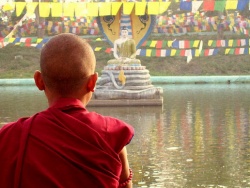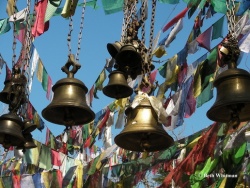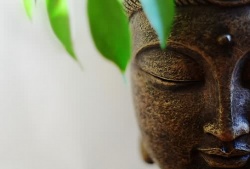Refuge
Buddhists "take refuge" in, or to "go for refuge" to, the Three Jewels (aka the "three refuges"). This can be done formally in lay and monastic ordination ceremonies.
refuge (Skt: sharana; Tib: kyab)
The door to the Dharma path. Having taken refuge from the heart we become an inner being or Buddhist. There are three levels of refuge—Hinayana, Mahayana and Vajrayana—and two or three causes necessary for taking refuge:
fearing the sufferings of samsara in general and lower realms in particular; faith that Buddha, Dharma and Sangha have the qualities and power to lead us to happiness, liberation and enlightenment; and (for Mahayana refuge) compassion for all sentient beings.
See also:
absolute refuge,
causal refuge,
conventional refuge,
resultant refuge.
The Three Jewels general signification is:
- The Buddha;
- the Dharma, the teachings;
- The Sangha, the community of (at least partially) Enlightened beings, often approximated to community of Monks and nuns (Bhikkhus and Bhikkhunis).
In Vajrayana, practitioners (sadhakas) can visualize the Refuge tree, and to aid this interior viewing, the Refuge tree is typically depicted on scroll paintings (Thangka) or murals.
History
In Buddhism, instead of looking for any external saviour, most Buddhists believe one can take refuge in oneself. From the Dhammapada:
- 160. One truly is the protector of oneself, who else could the protector be? With oneself fully controlled one gains a Mastery which is hard to gain. 165. By oneself is Evil done, by oneself is one defiled. By oneself is Evil left undone, by oneself is one purified. Purity and impurity depend on oneself--no one can purify another.
The Mahaparinibbana Sutta states, "For that which I have proclaimed and made known as the Dhamma and the Discipline, that shall be your Master when I am gone."
Faith (saddha)
- See also: Saddha
Faith (saddha/sraddha) is an important Buddha's teaching element in both the Theravada and Mahayana traditions. The Sanskrit word sraddha is translated as Faith; the original word has Trust, perseverance, humility and steady effort connotations. In contrast to Western notions of Faith, sraddha implies thorough reasoning and accumulated experience.
In the Kalama Sutra The Buddha explicitly argues against simply following authority or tradition, particularly those of religions contemporary to The Buddha's time.. There remains value for a degree of trusting confidence and belief in Buddhism, primarily in the spiritual attainment and salvation or Enlightenment through The Buddha's Wisdom. Faith in Buddhism centres on belief in the Three Jewels.
Vows
A student who takes refuge may make vows to adhere to The Five Precepts (pañca-Sila). Laypeople undertake at least one of the five, but traditions differ in how many vows are common to take. The Five Precepts are not commandments, such as "thou shalt not ...", but are promises to oneself: "I will (try) ..."
- To refrain from harming living creatures (killing).
- To refrain from taking that which is not given (stealing).
- To refrain from sexual misconduct.
- To refrain from false speech.
- To refrain from Intoxicants which lead to loss of Mindfulness.
Serious lay people or aspiring Monks may take an additional three to five ethical preceptsd strengthen some of The Five Precepts. For example, the precept pertaining to sexual misconduct becomes a precept of Celibacy.
Wording
Sanskrit version:
बुद्धं शरणं गच्छामि।
धर्मं शरणं गच्छामि।
संघं शरणं गच्छामि।
Buddhaṃ śaraṇaṃ gacchāmi.
Dharmaṃ śaraṇaṃ gacchāmi.
Saṃghaṃ śaraṇaṃ gacchāmi.
I take refuge in The Buddha.
I take refuge in the Dharma.
I Take Refuge in the Sangha.
Pāli (Theravāda) version:
Buddhaṃ saraṇaṃ gacchāmi.
Dhammaṃ saraṇaṃ gacchāmi.
Saṅghaṃ saraṇaṃ gacchāmi.
To The Buddha for refuge I go
To the Dharma for refuge I go
To The Sangha for refuge I go
Dutiyampi Buddhaṃ saraṇaṃ gacchāmi.
Dutiyampi Dhammaṃ saraṇaṃ gacchāmi.
Dutiyampi Saṅghaṃ saraṇaṃ gacchāmi.
For the second time ...
Tatiyampi Buddhaṃ saraṇaṃ gacchāmi.
Tatiyampi Dhammaṃ saraṇaṃ gacchāmi.
Tatiyampi Saṅghaṃ saraṇaṃ gacchāmi.
For the third time...
Uyghur version:
Namo but.
Namo dram.
Namo sang.
Chinese (Mahāyāna) version:
南無帰依佛 (to The Buddha for refuge I go)
南無帰依法 (to the Dharma for refuge I go)
南無帰依僧 (to The Sangha for refuge I go)
However, some substitute the above with mention of three refuge in Lotus Sutra which read,
自皈依佛,當願眾生,體解大道,發無上心。 (I take refuge in The Buddha, wishing for all Sentient beings to understand the great way and make the greatest vow.)
自皈依法,當願眾生,深入經藏,智慧如海。(I take refuge in the Dharma, wishing for all Sentient beings to deeply delve into the Sutra Pitaka, gaining an ocean of Knowledge.)
自皈依僧,當願眾生,統理大眾,一切無礙。(I Take Refuge in the Sangha, wishing all Sentient beings to lead the congregation in Harmony, entirely without obstruction.)
A Tibetan (Mahāyāna, Vajrayāna) version:
Until I am Enlightened,
I go for refuge to The Buddha, Dharma and Sangha.
Through the Virtue I create by practising giving and the other perfections,
may I become a Buddha to benefit all Sentient beings.
Sangye Cho dang Tsok kyi chog nam la
Jang Chub bar du dag gi jin gyat su chi
Dag gi jin so yi pe tsog nam ki
Dro la pen Chir Sangye drub par shok
Levels
According to Atisha in the 11th century Lamp for the Path, and in the subsequent Lamrim tradition as elaborated by Tsongkhapa, one can distinguish several levels of refuge. These purposes are introduced using the concept of the practitioner's "scope" of aspiration:
- Worldly scope is Taking Refuge to improve this Life (not Buddhist, since "to go for refuge perfectly we need to be motivated at least by concern for the welfare of future lives").
- Initial scope is Taking Refuge to gain higher Rebirth as a human or God, and to avoid the lower realms such as animal, hungry spirit, or Hell being.
- Intermediate scope is Taking Refuge to achieve Liberation or Nirvana.
- Great scope is Taking Refuge to achieve Enlightenment and become a Buddha for the benefit of all Sentient beings.
- Highest scope is also sometimes included, which is Taking Refuge to achieve Buddhahood in this Life (using Tantric Buddhism techniques).
Another distinction between different levels of Going for Refuge, given by Sangharakshita in his text Going for Refuge is:
- Ethnic refuge, when one is born into a Buddhist culture and practice is a matter more of social conditioning than personal commitment.
- Effective refuge, when one has taken the conscious decision to commit oneself to the three refuges, typically by joining a Buddhist Order.
- Real refuge, when the three Fetters of conditioned arising has been broken and stream entry has been attained.
- Absolute refuge, which corresponds with the attainment of Enlightenment.
The practice of Taking Refuge on behalf of young or even unborn children is mentioned in the Majjhima Nikaya, recognized by most scholars as an early text (cf infant baptism).
The Dhammapada
- See also:Dhammapada
- Driven only by fear, do men go for refuge to many places — to hills, woods, groves, trees and shrines.
- Such, indeed, is no safe refuge; such is not the refuge supreme. Not by resorting to such a refuge is one released from all Suffering.
- He who has gone for refuge to The Buddha, the Teaching and his Order, penetrates with transcendental Wisdom The Four Noble Truths — Suffering, the cause of Suffering, the cessation of Suffering, and the Noble Eightfold Path leading to the cessation of Suffering.
- This indeed is the safe refuge, this the refuge supreme. Having gone to such a refuge, one is released from all Suffering.
- — Dhammapada 188-192




